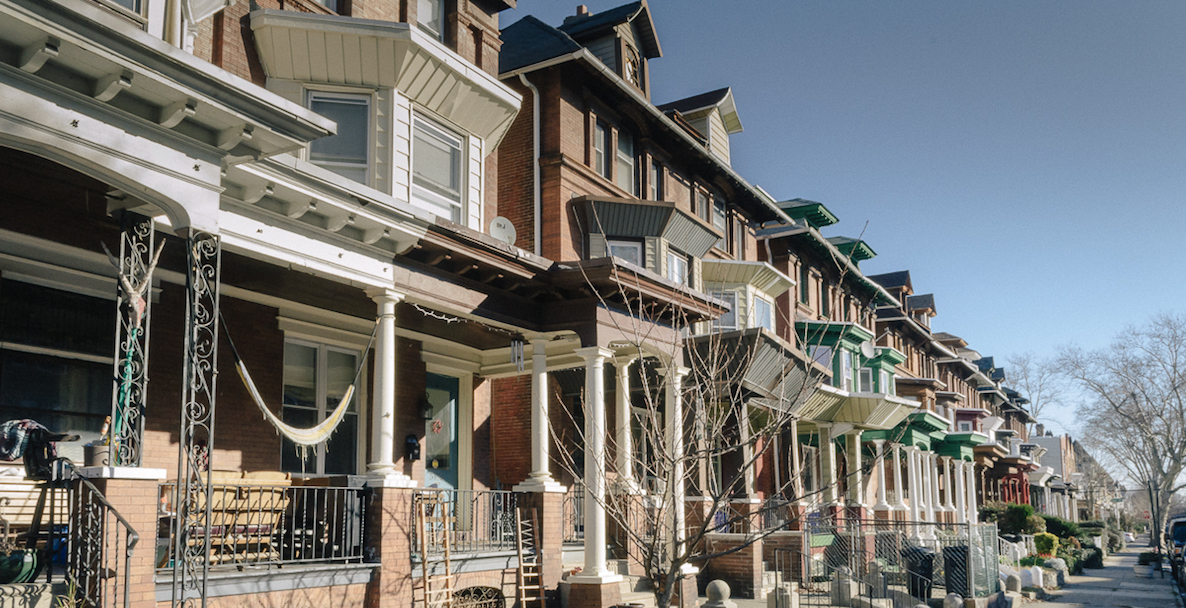A few days after her fourth birthday party, Adamaliz de los Santos got a gift from her mother, something that wasn’t on her wish list, yet couldn’t have been more special—not only in that moment but also befitting her daughter for years to come. With a knock on the door, it arrived: In came two strangers. They asked Adamaliz some questions about her birthday, her hobbies, her friends at school. They noticed dark circles under her eyes. Her hair looked sparse. Though she flashed big smiles, there were signs of stress beneath her buoyancy.
 Adamaliz, the middle child of three, lived with both parents in an apartment above a bodega in New Britain, Connecticut, a city of 70,000 known for its immigrant influence, including a strong contingent of families of the Puerto Rican diaspora. Adamaliz had standard middle-child traits in many ways. While she was needy for affection (like her younger sister) and had an independent streak (like her older sister), other uncontrollable behaviors proved to be problematic. Adamaliz plucked out her eyebrows during her sleep. She was aggressive towards her mother, scratching, cursing, and hitting. She would unconsciously tug at her mom’s hair when they slept in the same bed. Adamaliz often appeared spritely at play in one minute, then, flip like a light switch into bullying her sisters. Complicating matters was Adamaliz’s precocious ability to speak with adults, which was a skeleton key for getting into—and out of—trouble.
Adamaliz, the middle child of three, lived with both parents in an apartment above a bodega in New Britain, Connecticut, a city of 70,000 known for its immigrant influence, including a strong contingent of families of the Puerto Rican diaspora. Adamaliz had standard middle-child traits in many ways. While she was needy for affection (like her younger sister) and had an independent streak (like her older sister), other uncontrollable behaviors proved to be problematic. Adamaliz plucked out her eyebrows during her sleep. She was aggressive towards her mother, scratching, cursing, and hitting. She would unconsciously tug at her mom’s hair when they slept in the same bed. Adamaliz often appeared spritely at play in one minute, then, flip like a light switch into bullying her sisters. Complicating matters was Adamaliz’s precocious ability to speak with adults, which was a skeleton key for getting into—and out of—trouble.
“She’s not an easy kid, she’s really not,” says her mother, Jessica Bonilla. “Raising her has been tough.”
Jessica didn’t know what to do. She’d tried disciplining her daughter to no avail, which instead fed a feedback loop of anger, yelling and frustration that increasingly consumed their relationship. Fighting fire with fire is how Jessica learned to cope with stress growing up in between homes in Massachusetts and Puerto Rico. These were cultural hand-me-downs, deeply ingrained and derivative of Jessica’s own emotional history. That’s why Jessica invited these two women she’d never met into her home.
The women hailed from an organization called Child FIRST, a home-visiting program that’s a national leader in promoting mental health care as a means of improving outcomes for children living in at-risk families. Utilizing an intervention model called Child-Parent Psychotherapy (CPP), which was developed by San Francisco child trauma researcher Dr. Alicia Lieberman, a pioneer in the emergent field of infant mental health, Child FIRST works with children aged zero to six and their caregivers. Within Child FIRST, a licensed master’s level mental health clinician (who is usually a social worker) and a bachelor’s level coordinator get assigned as a team to a family, visiting them for hours on end every week to focus on the child-parent relationship (“the dyad”) as the vehicle for betterment.
Child FIRST has been statistically proven to improve the lives of families by bringing the dyad of parents and children closer together. Its mental-health-focused model might also be a missing component of the early-childhood system of intervention in Philadelphia.
In the case of Jessica and Adamaliz, the intervention took 18 months. Aside from behavioral concerns with Adamaliz, there were Jessica’s struggles—including depression, loneliness, and the stress of rental insecurity with her apartment, one that already felt small with all three girls sharing one bedroom—that required dealing with. These might sound like commonplace types of stress for families living in poverty, because they are.
But they’re also so detrimental to the cognitive and emotional development of children that experts have given them the term “toxic stress”—which can also arrive from physical abuse, neglect, malnutrition, homelessness and exposure to domestic violence. Roughly 80 percent of brain development occurs by the age of three, meaning that toxic stress can permanent alter the neurochemistry of the brain in the first few years of life, inhibiting key adult functions like memory, emotional regulation, and executive functioning.
Left untreated, toxic stress in the developing brain has been shown to put children at risk of developing cancer, drug addiction, teenage pregnancy, and depression later in life. In other words, it’s one of the most insidious forces working to prolong generational poverty among the most difficult-to-reach families.
The Child First intervention is unique because it combines two complementary approaches to healing from trauma and adversity. It directly decreases the stressors experienced by the family by connecting them to needed services and supports. And, it facilitates a nurturing, responsive parent-child relationship, which research has demonstrated protects the young developing brain and metabolic systems from the damaging effects of unavoidable stress. Child FIRST has been statistically proven to improve the lives of families by bringing the dyad of parents and children closer together. Its mental-health-focused model might also be a missing component of the early-childhood system of intervention in Philadelphia.

Over the last decade, home visiting programs have taken off in the United States in rare bipartisan form. One of the least controversial tenets of the 2010 Affordable Care Act was the establishment of a $1.5 billion federal funding stream for home visiting within the Department of Health and Human Services that is called Maternal, Infant, and Early Childhood Home, which has since been renewed by a Republican-controlled Congress. Today, there are thousands of home-visiting chapters operating throughout the United States, which reach more than 250,000 families annually. Home visiting exists in every state and almost half of all counties, according to the Urban Institute.
In Philadelphia, options include standard-bearers like the Nurse-Family Partnership and a home-based option of Early Head Start, although each home visiting program varies based on its focus, whether that’s focusing on a specific demographic, age, neighborhood or intervention practice. By and large these programs rely on nurses or social workers to visit homes. And since they are rarely medical providers themselves, they work more as liaisons or advocates for the families, connecting them with other outside exerts.
Part of the success behind Child FIRST lies in a non-triage approach to its services. The team isn’t teaching families solutions as much as it’s conditioning a thinking process to navigate toward those solutions, both immediately and long after Child FIRST exits the home.
This limitation within the home visiting sector was identified in a 2018 report by the William Penn Foundation, A Snapshot of the Home Visiting System in Greater Philadelphia: “Although parent education is a part of home visiting, a home visitor cannot directly provide all supports a family may need (e.g., substance use counseling, mental health services, health services etc.). A key feature of the home visitor’s role with families is to screen and refer families to other service providers in the community.”
For decades, Child FIRST has worked to bridge that gap in its home visiting, while becoming one the best statistically-proven models in the country. Child FIRST emerged during the mid-1990s at a time of great frustration and uncertainty among public health providers in Connecticut. There was public funding going toward the state’s low-income urban communities, but poverty rates had hardly improved. Connecticut was the richest per-capita state in the country, though it felt more like a third-world country in parts.
Public health providers wanted to know why the neediest families often slipped from a United Way study on Philly's home visiting system Read More
Lowell, who was running the Child Development Resource Service at a large hospital, found that many of the young children she was seeing not only had significant delays in their development, but major emotional and behavioral problems as well. Their families most often lived in poverty with multiple challenges, including maternal depression, PTSD, substance abuse, domestic violence, and homelessness. Both parents and children had experienced significant trauma. There were almost no mental health services for young children available.
“If you’re working with a family or a mom or a dad who’s had so much trauma in their lives that it’s causing them to be explosive with their children, it could be a sign that what’s happened to them in their own lives is preventing them from progress with their children,” Lowell says. “And if that’s the case, a parenting program isn’t going to work. You need to get at the root of what’s happening with them first.”
Using referrals from a local hospital, Lowell established the first FIRST team (an acronym standing for Family Interagency, Resource, Support, and Training) in the state’s poorest and most populous city, Bridgeport. Child FIRST only worked with families of children with significant relational or learning problems (i.e. high levels of toxic stress), the vast majority of them receiving public assistance. “Ninety-nine percent of our parents have had trauma in their lives,” says Lowell, now the chief executive officer of the Child FIRST nonprofit. “And we know that trauma affects the prefrontal cortex of the brain in ways that decreases or prevents the kind of executive functioning capacity to grow and develop like we would normally see. Not only do the parents have all these terrible experiences, but their brain hasn’t had the opportunity to develop as fully.
The first randomized control trial of the Child FIRST program turned up astonishing results. One year after intervention, which typically consists of between six and 12 months of visits, mothers reported a 64 percent drop in maternal depression and other mental problems; children were 40 percent less likely to exhibit aggressive behavior; and they were 68 percent less likely to have language problems. Overall, families were nearly 40 percent less likely to be involved with Child Protective Services, as measured in a follow-up three years after participation. There were major improvements in the dyadic relationship between caregiver and child, along with individual gains for the social and educational outcomes of children.
“If you can help a family get on a different trajectory, then, in the future, all the costs that they would normally incur that people complain about—TANF, unemployment, special education, hospitalization, incarceration—we can make a major dent in them,” says Lowell.
Getting there requires a deft, clinical approach. A social worker helps each family reach services that might stabilize or counteract their stress. For example, with Jessica and Adamaliz, her case manager scheduled appointments with a developmental pediatrician and a naturopathic doctor to get specialized advice on Adamaliz, while also working with Jessica on applications for housing vouchers. Meanwhile, during visits, a licensed therapist did exercises—sometimes individually, sometimes with the dyad—to try to boost self-regulation, resilience and executive functioning skills.
One of the primary goals of Child FIRST is to enhance parental reflectivity and empathy so that the caregiver can develop a deeper understanding of their child’s behavior, in order to better respond to their needs. “We talk about shifting a parent from a behavioral stance to an intentional stance,” says Dr. Salam Soliman, the national clinical director of Child FIRST. She draws up an example. “I’m thinking of a parent dropping off their child at daycare and the child is screaming and crying in the back seat because they don’t want to get out of the car. A behavioral stance would be, I need to get to work, this child is driving me crazy, they do this every day, I can’t ever get them out of the car.
“An intentional stance has to do with understanding the intent behind the behavior. Over time, we help the parent to think, why might they be doing that? We want parents to get to a point where they think, oh, maybe it’s hard for them to separate from me because there’s domestic violence at home and they think if they leave me, I might get hurt. Therefore, they want to stay with me and that’s why they struggle leaving the car.”
Part of the success behind Child FIRST lies in a non-triage approach to its services. The team isn’t teaching families solutions as much as it’s conditioning a thinking process to navigate toward those solutions, both immediately and long after Child FIRST exits the home. To illustrate, Lowell upends an old adage. “If you give a man a fish, he’ll eat for a day; if you teach a man to fish, he’ll eat for a lifetime,” says Lowell. “Except in Child FIRST we don’t teach. Our work is not through teaching; it’s psychotherapeutic and relationship based. We are helping parents develop capacities, both emotionally with their children and out in the world.”

Jessica Bonilla heard about Child FIRST from her sister, who’d been referred through a pediatrician a couple years earlier. Taking the leap of faith wasn’t easy. “I’m not usually a person to trust. I have to study a person first to see if I could open my doors to this person,” Jessica says.
Help Bring Child FIRST to PhillyDo Something
Every Child FIRST case differs, meaning there’s not a standard checklist to accomplish before discharge. However, there are the generally shared goals of stress reduction, behavioral improvement, and improved access to community services. These came gradually over time with Jessica and Adamaliz.
When Luciano and Rodriguez began visiting, Adamaliz would refuse to participate in the activity du jour—play-doh, bubbles, coloring—whenever it wasn’t to her liking; sulking, yelling and bullying often followed. “We spoke a lot with Jessica about not responding to the behavior, but rather responding to the message behind the behavior,” Rodriguez says. Conversely, they worked with Adamaliz on regulating her impulses and shifting her language. “A few months in, she started picking up on the language we were using, saying ‘no thank you, m’am,’ instead of yelling,” Luciano says. “Sometimes, having another adult in the house telling you that how you’re feeling is okay but your behavior is not is important.
Then, at the 11-month mark of the intervention, Adamaliz’s father moved out. There was suddenly more trauma to worry about. Unlike a lot of social programs, eligibility for Child FIRST doesn’t end after a specific interval, so Luciano and Rodriguez were able to continue working with the family for another half-year, until Jessica and Adamaliz were able to relocate to a new home in the nearby town of Bristol, Connecticut.
Despite ending their formal visits, Rodriguez and Luciano still receive texts of Adamaliz at gymnastics or playing with her sisters. “I wish I can get them back. They’re like my family now,” Jessica says.

Child FIRST is only one of a dozen home-visiting programs nationally that have received the distinction of being “evidence-based” from the Department of Health and Human Services. It’s also the only psycho-therapeutic intervention in the home visiting sector that gets federal MIECHV funding.
That’s not a huge surprise given the clinical nature of the model. The salary of a master’s-level licensed behavioral therapist can be equal to that of multiple social workers, a prohibitive cost for most home-visiting programs that would otherwise be receptive to directly providing mental health services to families. Plus, the Child FIRST model requires internal mental-health structures for its employees that demand resources. Every week, all of the visitors complete three-and-a-half hours of reflective supervision for their own sake, in order to prevent burnout and the consequences of secondary trauma.
Mothers reported a 64 percent drop in maternal depression and other mental problems, children were 40 percent less likely to exhibit aggressive behavior, plus were 68 percent less likely to have language problems. Overall, families were 40 percent less likely to be involved with Child Protective Services, as measured in a follow-up three years after participation.
“It doesn’t work if you don’t offer a tremendous level of support,” says Dr. Lowell. “What we’ve often found is that the folks with the least amount of support do the hardest frontline work. That’s why we do individual, team, and group reflective supervision every week. It’s a wonderful thing, but it could be perceived as a potential barrier.”
It’s also true that economists have trumpeted home-visiting programs as one of the most cost-effective public health approaches in the country. For example, an independent evaluation of just one model in New York City, the Parent-Child Home Program, concluded that the average intervention (costing about $4,500 over two years) saved more than $200,000 per child over time and increased participants’ lifetime earnings by between a half-million and $1 million. A RAND Corporation analysis of multiple home-visiting models suggested the return on investment of evidence-based home visiting models is anywhere between $1.80 and $5.70 per public dollar given out.
While at $9,000 per family, the cost of Child FIRST is more expensive than other models, the need for more mental health care within this sector is also becoming more and more apparent. After growing to 15 location in Connecticut, Child FIRST is now operating in Florida and North Carolina, with eyes on setting up centers elsewhere in the near future. “The need is gigantic,” says Lowell. “We serve the very highest-need families and it is really an incredibly cost-effective way to deliver services, despite being expensive.”
That’s in part why Child FIRST’s phones are ringing with calls from counties and wants your tipsBroke in Philly
Regarding the first question, the need is undeniable in Philadelphia, the poorest big city in the country. For the second, while there are several evidence-based home visiting options for families to choose from here, there’s no one replicating Child FIRST’s commitment to bringing mental health treatment into the homes of families.
According to Child FIRST, the first year startup costs for an affiliate program in Philadelphia or elsewhere that could serve 60 families is in the neighborhood of $900,000, which includes the costs of salaries, training, and licensing. Over time, costs reduce dramatically. That money might exist here: After identifying early childhood as one of five high-priority policy areas, Governor Tom Wolf in 2017 announced that his administration would funnel a $12 million infusion of MIECHV funding into four evidence-based models statewide. Perhaps next go-round, if there is one, he could include Child FIRST among his recipients.
Lowell insists that the program doesn’t actively recruit new destinations for its services and the program’s expansion into North Carolina and Florida was driven by inquiries from those localities. But it doesn’t mean Child FIRST is standing pat. “We could serve 10 times the number of families that we now serve if we had the capacity, if we had the resources,” says Lowell. “Ultimately, if you can help a family get on a different trajectory, then, in the future, all the costs that they would normally incur that people complain about—TANF, unemployment, special education, hospitalization, incarceration—we can make a major dent in them.
“It’s because we believe in the potential of our families and the real possibilities for change and growth. That’s because we’ve seen it.”
Corrections: An earlier version of this story misstated who is assigned to each family. It is a licensed master’s level mental health clinician (who is usually a social worker) and a bachelor’s level coordinator. A previous version also slightly misstated the cost; it is $9,000 per family.
Photo via: Child FIRST






